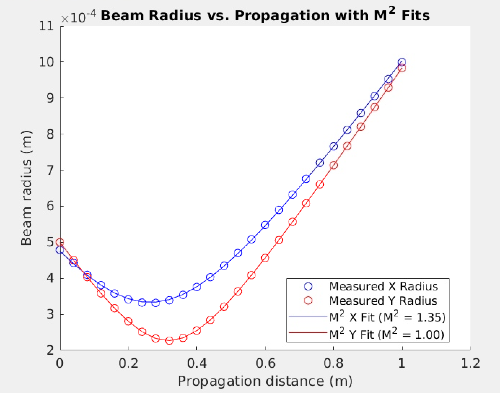Calculating the M² Beam Parameter from Simulation Results
Calculating the M² Beam Parameter from Simulation Results
In this post, I will walk through the steps required to calculate the M² beam quality factor from simulation results using data obtained from beam propagation through focus.
The M² parameter is an important factor for characterizing the quality of laser beams, especially when comparing how closely the beam approximates an ideal Gaussian profile.
Simulation Setup
First, we set up a 3D simulation to propagate the beam through a focus. In this setup, the key parameters such as the propagation length, material, and beam radii in the x and y directions are defined.
The detector captures the caustic of the beam, which is necessary to calculate the beam waist and Rayleigh range from which the M² is determined.
% Initialize the simulation object
obj = chi3D('tag', 'M2 fit');
% Clear previous detectors and results
obj.removeDetectors('all');
obj.detectors.caustic.plotIntegratedProfiles=1;
obj.clearResults;
% Define the propagation through focus
obj.run({'pulse1', ...
'propagationLength', 1, ...
'material', 'Air', ...
'eoo', 0, ...
'Nz', 25, ...
'showResultEach', 1, ...
'radiusOfCurvature_x', 0.5, ...
'radiusOfCurvature_y', 0.4, ...
'xWindow', 5e-3, ...
'yWindow', 5e-3, ...
'beamRadius_x', 0.4e-3, ...
'beamRadius_y', 0.5e-3, ...
'beamShape_x', {'supergauss', [5]} ...
});
Extracting and Fitting the Data
After running the simulation, we extract the beam propagation data. This data contains the beam diameters in the x and y directions, and the propagation distances.
From this, we calculate the beam radii by dividing the diameters by 2.
% Measured data for beam propagation in x and y directions
z = obj.simResults.caustic.z; % Propagation distances
radius_x = obj.simResults.caustic.diameter2M_x / 2; % Beam radius in x-direction
radius_y = obj.simResults.caustic.diameter2M_y / 2; % Beam radius in y-direction
% Center wavelength
lambda_0 = obj.simResults.caustic.centerWavelength(end); % Laser wavelength
Beam Propagation Model and Fitting
The beam propagation is modeled using the equation:
w(z) = w₀ * sqrt(1 + ((z - z₀) / zR)²)
Here, w(z) is the beam radius at a distance z from the beam waist, w₀ is the beam waist radius, z₀ is the location of the waist, and zR is the Rayleigh range.
We use nonlinear least squares fitting to fit the measured data to this model, which allows us to extract w₀, z₀, and zR for both x and y directions.
% Define the beam propagation model: w(z) = w_0 * sqrt(1 + ((z - z_0) / z_R)^2)
beamRadiusModel = @(params, z) params(1) * sqrt(1 + ((z - params(2)) / params(3)).^2);
% Initial guesses for the fit parameters (x and y)
initialGuess_x = [min(radius_x), mean(z), (max(z) - min(z)) / 2];
initialGuess_y = [min(radius_y), mean(z), (max(z) - min(z)) / 2];
% Perform the fit using nonlinear least squares for both x and y directions
options = optimset('TolFun', 1e-9, 'MaxIter', 1000);
fitParams_x = lsqcurvefit(beamRadiusModel, initialGuess_x, z, radius_x, [], [], options);
fitParams_y = lsqcurvefit(beamRadiusModel, initialGuess_y, z, radius_y, [], [], options);
Calculating the M² Parameter
After fitting the model, we can calculate the M² parameter using the formula:
M² = (π * w₀²) / (λ * zR)
This calculation is performed for both the x and y directions based on the fitted parameters w₀ and zR.
% Extract fitted parameters and calculate M² for x and y directions
w0_x = fitParams_x(1); % Beam waist radius in x
zR_x = fitParams_x(3); % Rayleigh range in x
M2_x = (pi * w0_x^2) / (lambda_0 * zR_x); % M² for x-direction
w0_y = fitParams_y(1); % Beam waist radius in y
zR_y = fitParams_y(3); % Rayleigh range in y
M2_y = (pi * w0_y^2) / (lambda_0 * zR_y); % M² for y-direction
Plotting the Results
Finally, we plot the measured data points along with the respective fitted curves for both the x and y directions. The plots also show the calculated M² values.
% Generate fitted curves
fit_x = beamRadiusModel(fitParams_x, z);
fit_y = beamRadiusModel(fitParams_y, z);
% Plot the results
figure;
hold on;
% Plot measured data points and fitted curves for x and y directions
plot(z, radius_x, 'bo', 'DisplayName', 'Measured X Radius');
plot(z, radius_y, 'ro', 'DisplayName', 'Measured Y Radius');
plot(z, fit_x, 'b-', 'DisplayName', sprintf('M^2 X Fit (M^2 = %.2f)', M2_x));
plot(z, fit_y, 'r-', 'DisplayName', sprintf('M^2 Y Fit (M^2 = %.2f)', M2_y));
% Set labels, title, and legend
xlabel('Propagation distance (m)');
ylabel('Beam radius (m)');
legend('Location', 'best');
title('Beam Radius vs. Propagation with M^2 Fits');
hold off;

Conclusion
This method provides an accurate way to extract the beam quality factor M² from the simulated beam propagation data. By fitting the measured data to the beam propagation model, we can determine the beam waist, Rayleigh range, and the M² value for both the x and y directions.
Tino Lang

